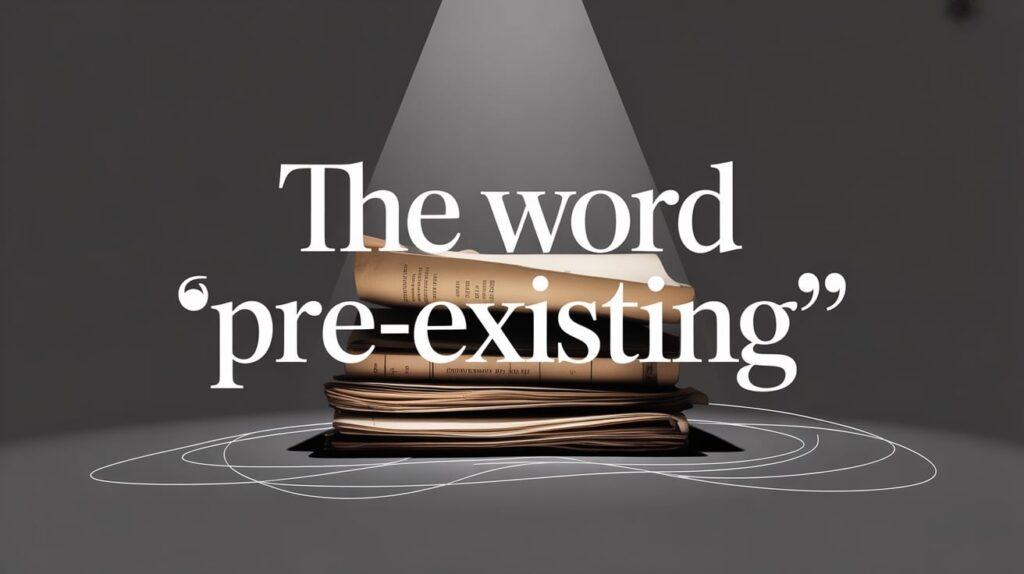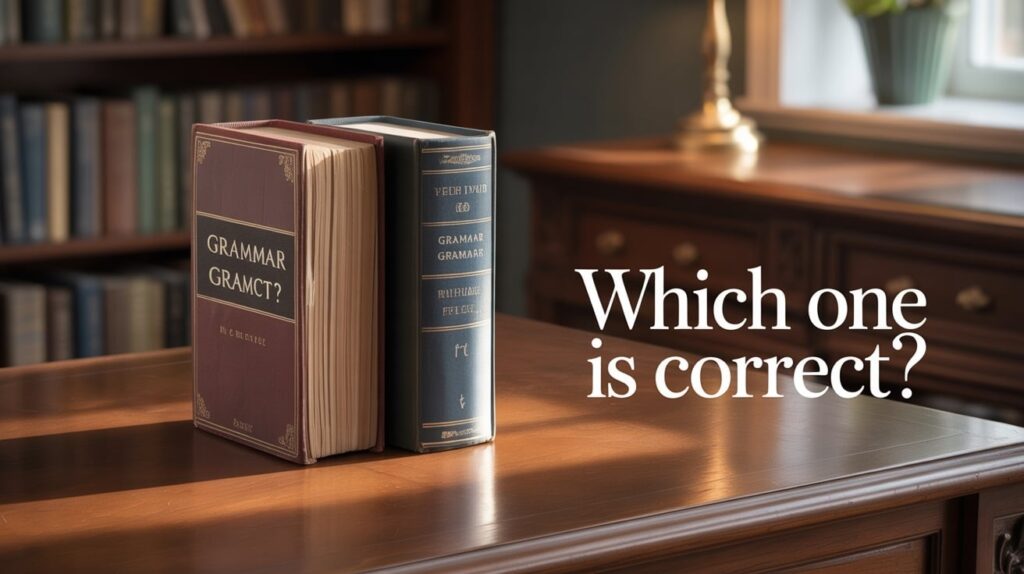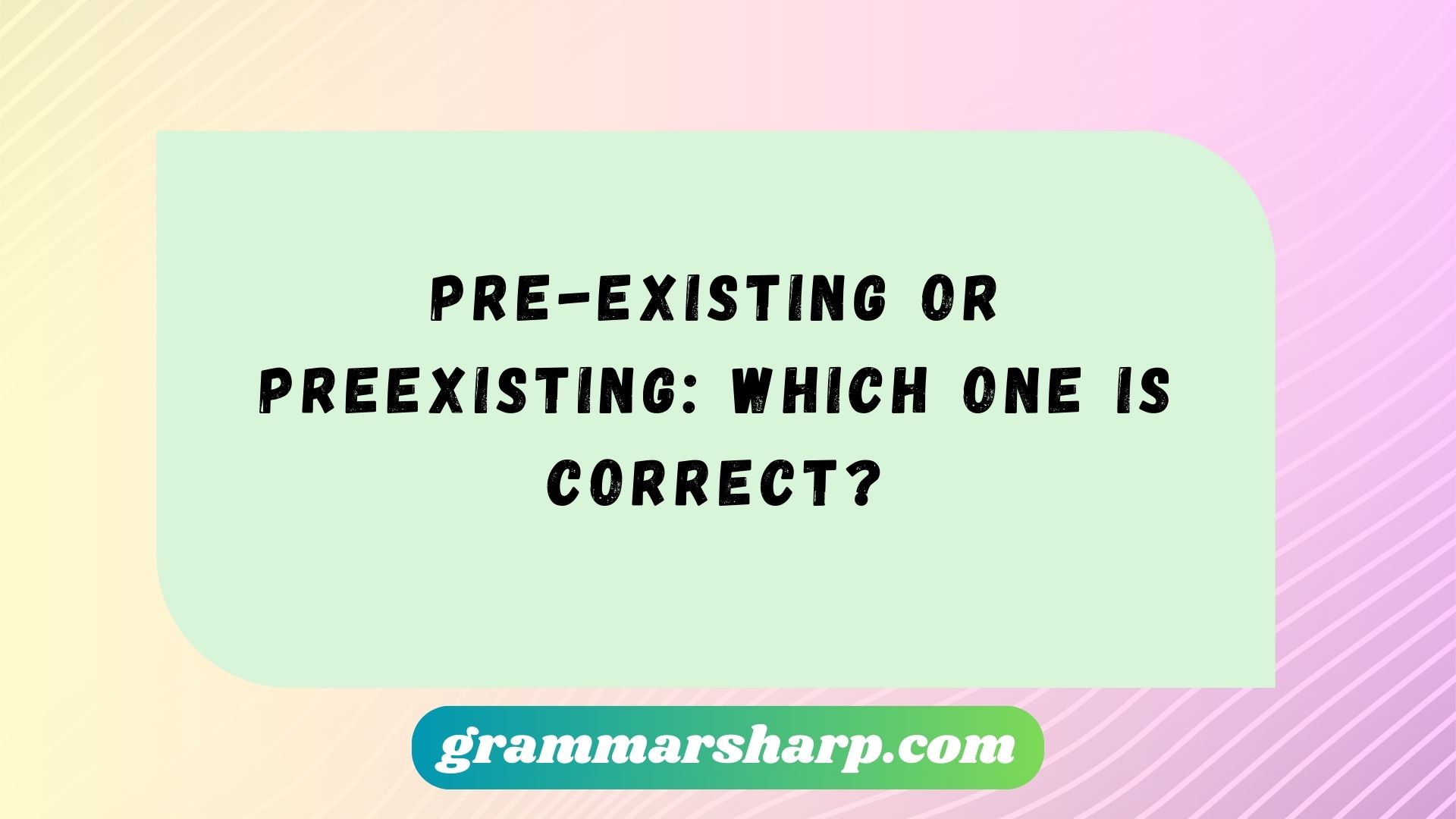English can be tricky, especially when it comes to hyphenated words. One of the most common debates centers on whether to write “pre-existing” with a hyphen or “preexisting” without one. At first glance, the difference seems minor—a simple dash—but for writers, students, professionals, and even lawyers, the choice can matter.
Language is always evolving. What used to be correct fifty years ago may look outdated today. For example, words like “e-mail” slowly transitioned into “email” as usage changed. The same thing is happening with “pre-existing” and “preexisting.” Both forms are widely understood, but depending on the context, one may be more accepted than the other.
You might wonder: Do style guides like APA, AP, or Chicago Manual of Style favor one form? Do dictionaries agree on a single spelling? What about legal and medical documents—do they stick to tradition? And most importantly, how should you write it to look professional and accurate?
This guide will break it down for you step by step. By the end, you’ll not only know which form is correct, but also when and where to use it.
Understanding the Prefix “Pre-”
The confusion around “pre-existing” versus “preexisting” comes from how English handles prefixes.
- The prefix “pre-” means before or prior to.
- In general, prefixes in English often attach directly to the root word without needing a hyphen.
- For example: preheat, preschool, preview, prepay.
But here’s the catch: sometimes, we still use a hyphen for clarity or tradition. Hyphens appear when:
- A double vowel could cause misreading (e.g., pre-election, re-enter).
- The unhyphenated version looks awkward or confusing.
- Style guides recommend a hyphen in formal settings.
So, the prefix itself isn’t the problem—it’s how English convention has treated this particular word.
The Word “Pre-Existing”

The form “pre-existing” has been around for much longer than its unhyphenated twin. Historically, English leaned heavily on hyphens when combining prefixes with root words. That’s why dictionaries from the early 20th century list “pre-existing” as the preferred form.
Meaning: Something that already existed before a specific time or event.
Examples in sentences:
- “The contract acknowledges all pre-existing conditions.”
- “She had a pre-existing interest in photography before enrolling in the course.”
Writers, especially in legal and medical fields, continue to use this hyphenated form. It feels more formal and traditional, and in contracts, precision matters. A misplaced hyphen can sometimes alter meaning, so legal writing tends to err on the side of caution.
Quote:
“In legal writing, consistency matters more than trends. If a contract begins with ‘pre-existing,’ it must continue that way throughout.” – Legal Writing Institute
The Word “Preexisting”
Over time, the unhyphenated “preexisting” gained popularity. Modern English favors simpler, cleaner forms, especially in casual and academic writing. The trend follows the same path as words like “email” (once “e-mail”) and “online” (once “on-line”).
Meaning: Exactly the same as “pre-existing”—something that already exists before a particular event.
Examples in sentences:
- “Researchers studied preexisting medical conditions in the population.”
- “The museum sits on land with a preexisting structure.”
Most modern dictionaries, including Merriam-Webster and Oxford, now list both forms as correct, with “preexisting” often marked as the primary spelling.
Why it’s common today:
- Simpler and faster to type.
- Aligns with modern English simplification.
- Matches the style of other prefix words like premade and preplanned.
Which One Is Correct?

The short answer: Both are correct.
But context makes all the difference. Let’s look at what leading references say:
| Source | Preferred Form | Notes |
| Merriam-Webster | preexisting | Lists “pre-existing” as a variant |
| Oxford English Dictionary | pre-existing | Hyphenated form still standard |
| Cambridge Dictionary | pre-existing | Hyphenated version given first |
| APA Style | preexisting | Encourages modern form |
| Chicago Manual of Style | preexisting | Hyphen avoided unless needed |
| AP Stylebook | pre-existing | Uses hyphen for clarity in journalism |
Takeaway: Dictionaries and style guides disagree, but the trend clearly leans toward preexisting without the hyphen.
Pre-Existing vs Preexisting in Different Fields
Certain industries and professions prefer one spelling over the other.
- Medical field: Insurance policies still write “pre-existing conditions” because it’s traditional and legally precise.
- Legal documents: Contracts, deeds, and statutes often stick with the hyphen for consistency.
- Academic writing: Journals and research papers increasingly use “preexisting.”
- Business/marketing: Most businesses prefer the simpler “preexisting.”
Case study – Health Insurance:
In the United States, the Affordable Care Act (ACA) famously banned insurance companies from denying coverage based on pre-existing conditions. Even though modern English leans toward “preexisting,” lawmakers chose the hyphenated form for clarity in legal texts. This choice shows how tradition still shapes high-stakes language.
Grammar and Hyphenation Rules to Remember
To understand why both forms exist, it helps to review hyphen rules:
- Hyphenate prefixes when:
- The root word starts with the same vowel (e.g., pre-election, re-enter).
- The unhyphenated form could confuse readers (e.g., pre-school vs preschool).
- The context is formal/legal and precision matters.
- Don’t hyphenate prefixes when:
- The word is widely accepted without one (e.g., email, nonprofit, preexisting).
- The meaning remains clear.
Tip: If you’re ever unsure, check a dictionary or follow the style guide required by your employer, school, or publisher.
Examples in Sentences
To illustrate the difference, here’s a comparison of both spellings in context:
| Sentence | Hyphenated | Unhyphenated |
| Insurance | The policy covers all pre-existing conditions. | The policy covers all preexisting conditions. |
| Medical | Patients with pre-existing heart problems should consult a doctor. | Patients with preexisting heart problems should consult a doctor. |
| Business | The merger recognized pre-existing agreements. | The merger recognized preexisting agreements. |
| Academic | The study excluded participants with pre-existing biases. | The study excluded participants with preexisting biases. |
Both are correct, but the tone changes slightly: hyphenated feels formal, while unhyphenated feels modern and streamlined.
Common Mistakes and Misconceptions
- Myth: One version is wrong. (Fact: Both are correct depending on context.)
- Mistake: Switching between “pre-existing” and “preexisting” in the same document. (Tip: Pick one and stay consistent.)
- Misconception: Hyphens always make writing clearer. (In many cases, they clutter text and slow down reading.)
Which Should You Use? Practical Guidelines
Here’s a quick reference guide:
- Writing academically? Use “preexisting” unless your professor or journal specifies otherwise.
- Writing legally? Stick with “pre-existing” for consistency.
- Writing casually? Either works, but “preexisting” is modern and more common.
- Unsure? Check the dictionary your audience uses, or follow the style guide in place.
Golden rule: Consistency is more important than which form you choose.
Related Words and Patterns
Language changes over time, and hyphens often disappear as words become familiar. Here are examples:
| Older Form | Modern Form |
| on-line | online |
| non-profit | nonprofit |
| pre-existing | preexisting |
| co-operate | cooperate |
The same trend applies to pre-existing—over time, it’s slowly shifting toward “preexisting.”
Conclusion
So, which is correct: pre-existing or preexisting? The truth is both forms are acceptable, but context and consistency matter most. Dictionaries and style guides vary, yet the modern trend strongly favors preexisting without the hyphen.
If you’re writing in a legal or medical context, “pre-existing” remains the safer choice. But if you’re writing for casual, academic, or business purposes, “preexisting” is the cleaner, more widely used option.
Key takeaway: Language evolves, but your credibility as a writer depends on consistency. Pick one form and stick with it throughout your work.
FAQs
Is pre-existing always hyphenated in legal writing?
Not always, but legal documents often use “pre-existing” for tradition and clarity.
Does APA style use preexisting or pre-existing?
APA recommends “preexisting” without the hyphen.
Why do some dictionaries list both versions?
Because usage is split. Dictionaries document language as it’s used, not just how it should be.
Is one spelling more professional than the other?
“Pre-existing” feels more formal; “preexisting” feels modern. Both are professional if used consistently.
Will “pre-existing” eventually disappear?
Most likely. Just like “e-mail” became “email,” the hyphen may vanish with time.

